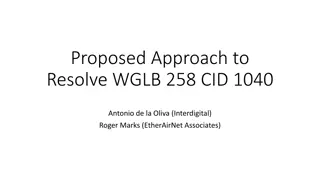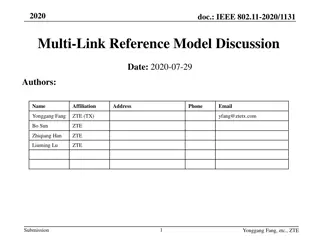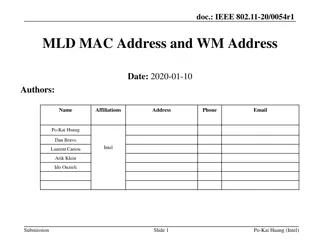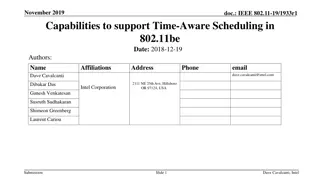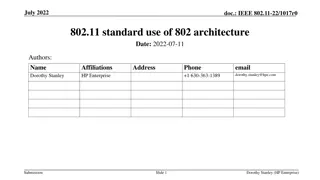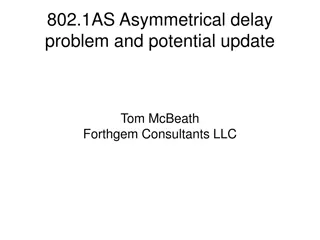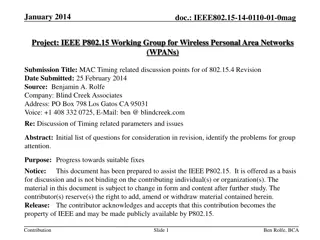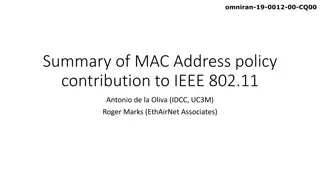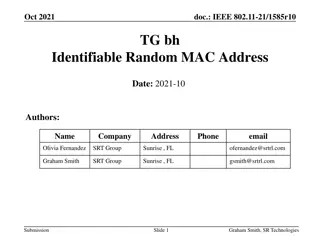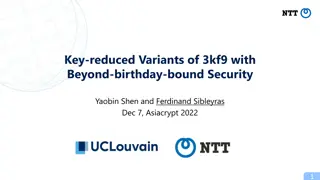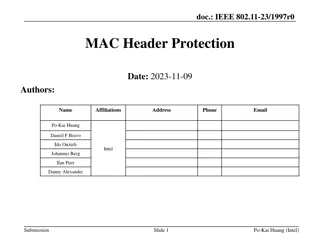
Enabling Time-Aware Traffic Shaping in IEEE 802.11 MAC
This presentation discusses solutions to implement Time-Aware Traffic Shaping (802.1Qbv) in the 802.11 MAC for controlling latency in time-sensitive and real-time applications. It delves into TSN standards, TSN components, and the benefits of Time-Aware Shaping in managing frame transmissions effectively. The content explores the significance of synchronization, low latency, and reliability in network communications. Specific protocols and standards like Frame Replication and Elimination, Path Control, and Reservation are addressed, emphasizing the importance of predictable and periodic traffic handling. The presentation underscores the significance of Time-Aware Shaping for ensuring low jitter and worst-case latency while prioritizing time-critical frame transmissions over lower-priority frames.
Download Presentation

Please find below an Image/Link to download the presentation.
The content on the website is provided AS IS for your information and personal use only. It may not be sold, licensed, or shared on other websites without obtaining consent from the author. If you encounter any issues during the download, it is possible that the publisher has removed the file from their server.
You are allowed to download the files provided on this website for personal or commercial use, subject to the condition that they are used lawfully. All files are the property of their respective owners.
The content on the website is provided AS IS for your information and personal use only. It may not be sold, licensed, or shared on other websites without obtaining consent from the author.
E N D
Presentation Transcript
November 2018 Time-Aware shaping (802.1Qbv) support in the 802.11 MAC Date: 2018-11-10 doc.: IEEE 802.11-18/1892r0 Authors: Name Dave Cavalcanti Affiliations Address Phone email Mamun Rashid 2111 NE 25th Ave, Hillsboro OR 97124, USA Ganesh Venkatesan Intel Laurent Cariou Robert Stacey Submission Slide 1 Dave Cavalcanti, Intel
November 2018 doc.: IEEE 802.11-18/1892r0 Abstract This presentation describes potential solutions to enable Time-Aware (8021Qbv) Traffic Shaping over the 802.11 MAC in order to control latency for time-sensitive and real-time applications. Submission Slide 2 Dave Cavalcanti, Intel
November 2018 doc.: IEEE 802.11-18/1892r0 Outline TSN Background Time-Aware (802.1Qbv) traffic shaping Time-Awareness within the 802.11 MAC Conclusions Submission Slide 3 Dave Cavalcanti, Intel
November 2018 doc.: IEEE 802.11-18/1892r0 IEEE 802.1 Time-Sensitive Networking (TSN) Standard Ethernet with Synchronization, small and/or fixed latency, and extremely low packet loss TSN Components Common Standards Time synchronization: Time Synchronization (802.1AS) 802.1AS over 802.11 Timing Measurement (TM) Fine Timing Measurements (FTM) Ultra reliability: Frame Replication and Elimination (P802.1CB) Path Control and Reservation (802.1Qca) Per-Stream Filtering and Policing (802.1Qci) Reliability for time sync (P802.1AS-Rev) Synchronization Reliability Reliability Latency Bounded low latency: Time-Aware traffic shaping (802.1Qbv) Preemption (802.1Qbu/802.3br) Cyclic Scheduling (802.1Qch) Asynchronous Scheduling (802.1Qcr) Dedicated resources & API Stream Reservation Protocol (802.1Qat) TSN configuration (P802.1Qcc) YANG (P802.1Qcp) Link-local Registration Protocol (P802.1CS) Resource Mgmt Zero congestion loss Time-Aware shaping (802.1qbv) over 802.11 (extension to address latency) 802.11aa (SRP over 802.11 for AV) 802.11ak (802.11 links in an 802.1Q network) Credit: J nos Farkas, Ericsson TSNA Conference 2017, http://www.tsnaconference.com/ Submission Slide 4 Dave Cavalcanti, Intel
November 2018 doc.: IEEE 802.11-18/1892r0 Time-Aware Traffic Shaping Scheduling time-critical frame transmissions while avoiding contention with lower priority frames can give low jitter and guarantee worst case latency 802.1Qbv defines Time-Aware shaper for Ethernet switches Queues/Traffic classes Multiple queues are controlled based on a repeating schedule (time, gate open/closed), time reference is provided by 802.1AS Qbv can be very effective, especially for predictable, periodic traffic T T T T T T T T frame selection Transmission time gate open gate open gate closed gate open gate closed Submission Slide 5 Dave Cavalcanti, Intel
November 2018 doc.: IEEE 802.11-18/1892r0 Time-Aware Shaping over Wireless Time-Aware shaping sitting on top of 802.11 MAC can resolve contention within each device and across multiple STAs/AP that share the medium Assumptions: managed network and 802.11 admission control is used for TSN traffic Example Scenario AP Time-Sensitive Traffic Other Traffic T T T T gates closed AP gate open gate open All gates open gates closed gate open STA 1 (Normal Operation) Shared medium gates closed gate open STA 2 T T T T T T T T The Qbv schedule defines when the gates open/close (implementation specific) The schedule can take into account the 802.11 MAC/PHY mode (e.g. EDCA, 11ax DL/UL OFDMA, TWT, ) STA 2 STA 1 Submission Slide 6 Dave Cavalcanti, Intel
November 2018 doc.: IEEE 802.11-18/1892r0 Simplified TSN Reference Stack Application Transport IP Encapsulation Direct L2 access IP IEEE 802.1 Network Link Layer TSN Capabilities: time sync, time-aware, reservations, and many others MAC/PHY IEEE 802.11 (Wi-Fi) IEEE 802.3 (Ethernet) Media Specific Support required for TSN Capabilities 802.11 requirements for Time-Aware (Qbv) capability: Exchange the 802.1Qbv schedule between managed STAs Rules to certify the release of frames from the 802.11 queues according to the 802.1Qbv defined times and avoid contention between queues Submission Slide 7 Dave Cavalcanti, Intel
November 2018 doc.: IEEE 802.11-18/1892r0 Intra-STA contention problems for time- sensitive frames Time-sensitive frame Collisions between EDCA functions are resolved within STAs high priority AC frames are transmitted and lower priority AC(s) backoff On avg, high priority AC should get faster access, but a time-sensitive frame may still have to wait in some situations, e.g.: other frames in the same AC Queue other ACs get access first ongoing (long) TXOP from another AC The time-aware concept can prevent some of the situations that increase worst case latency for time-sensitive frames Time-sensitive frame TXOP (AC_VI) Submission Slide 8 Dave Cavalcanti, Intel
November 2018 doc.: IEEE 802.11-18/1892r0 Time-Awareness in the 802.11 MAC (option 1 TSN queue) SME-MLME SAP A Time-Aware schedule defined (e.g. 802.1Qbv layer, other higher layer, ) A queue for TSN traffic A Time-Aware Shaper Function pauses/resumes EDCAFs to avoid contention A frame selection function (implementation dependent) selects TSN frame(s) for transmission within SP TSN Access Function: follows selected access mode rules (e.g. EDCA with existing/new AC parameters, 11ax Trigger-based access, ) Time-Aware Shaper Function Time-sensitive frame selection Pause/Resume EDCAFs TSN Service Internal Service Period Service Period EDCAFs resume normal operation 1. TSN Queue Open 2. Other EDCAFs paused 3. Time-Sensitive frames selected/transmitted Submission Slide 9 Dave Cavalcanti, Intel
November 2018 doc.: IEEE 802.11-18/1892r0 Time-Awareness in the 802.11 MAC (option 2 TSN reuses EDCA queue) A Time-Aware schedule defined (e.g. 802.1Qbv layer, other higher layer, ) A TSN stream uses one of the EDCA queues (e.g. VO) A Time-Aware Shaper Function pauses/resumes competing EDCAFs to avoid contention A frame selection function (implementation dependent) selects TSN frame(s) for transmission within SP Frame is transmitted using EDCAF (e.g. AC_VO), other access methods could also be used (e.g. 11ax Trigger-based) Service Internal Service Period Service Period EDCAFs resume normal operation 1. AC_VO (Time-sensitive Queue) Open 2. Other EDCAFs paused 3. Time-Sensitive frames selected/transmitted Submission Slide 10 Dave Cavalcanti, Intel
November 2018 doc.: IEEE 802.11-18/1892r0 Time-Aware Shaping within managed BSSs The 802.11 MAC provides an interface (primitive at the SME-MLME SAP) to configure the Time-Aware Shaper Function in each managed STA A 802.1Qbv scheduler (higher layer implementation) is responsible for resolving contention across all managed STAs The schedule must be communicated to managed STAs (new management frame can be defined) A Time-Aware Scheduler may control multiple BSSs The schedule can be distributed by higher layers All managed BSSs (and STAs) must synchronize to the same time source as the Time-Aware scheduler Submission Slide 11 Dave Cavalcanti, Intel
November 2018 doc.: IEEE 802.11-18/1892r0 Access mechanism for time-sensitive traffic The Time-Aware functionality is independent of the access mechanism used Various access modes can be used: EDCA, 802.11ax Trigger- based Access, Access mode could be a configuration parameter for the TSN Access Function (option 1) Admission control can be used to ensure low latency performance 802.11ax capabilities help increase efficiency STAs can be configured to use Trigger-based access The AP can schedule UL/DL to comply with the SP boundaries The AP may opportunistically schedule other traffic without impacting the time-sensitive traffic Submission Slide 12 Dave Cavalcanti, Intel
November 2018 doc.: IEEE 802.11-18/1892r0 Impact of unmanaged BSSs Time-Aware shaping operates on managed STAs Interfering transmissions may impact the capability to guarantee bounded latency Unmanaged STAs/BSSs are seen as interference The Time-Aware scheduler can take into account the level of interference when admitting TSN flows and defining SP durations Latency bound vs. capacity tradeoffs will depend on the level of interference and deployment scenario Submission Slide 13 Dave Cavalcanti, Intel
November 2018 doc.: IEEE 802.11-18/1892r0 Conclusions Time-Aware traffic shaping is a TSN capability to control congestion and worst case latency in managed networks The 802.11 MAC can enable this capability through a Time-Aware Shaper Function Avoid contention from competing traffic between managed STAs, and reduce worst case latency (important for real-time/time- sensitive applications) Modifications are limited to controlling queues and do not require new channel access mechanism This capability will also enable 802.11 to be integrated with Ethernet-based TSN Submission Slide 14 Dave Cavalcanti, Intel
November 2018 doc.: IEEE 802.11-18/1892r0 References IEEE Std 802.1Qbv-2015. Submission Slide 15 Dave Cavalcanti, Intel

